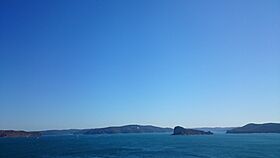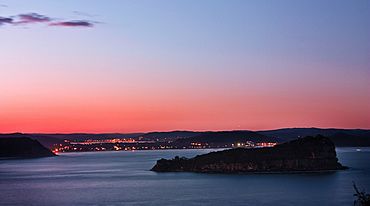Lion Island (New South Wales) facts for kids

View of Lion Island from Iron Ladder Beach
|
|
| Geography | |
|---|---|
| Location | Broken Bay |
| Administration | |
|
Australia
|
|
| State | New South Wales |
| Lion Island Nature Reserve New South Wales |
|
|---|---|
|
IUCN Category Ia (Strict Nature Reserve)
|
|

Sunset view of Lion Island
|
|
| Nearest town or city | Gosford |
| Established | 1956 |
| Area | 0.08 km2 (0.0 sq mi) |
| Managing authorities | NSW National Parks & Wildlife Service |
| See also | Protected areas of New South Wales |
Lion Island is a small island located at the mouth of the Hawkesbury River in Broken Bay, New South Wales, Australia. It is found just off Pearl Beach. The island is part of the Central Coast area. It is called Lion Island because its shape looks like a crouching lion, similar to the mythical Sphinx.
Contents
Why is it Called Lion Island?
The island was first named Mount Elliott Island in 1789 by Governor Arthur Phillip. He named it after his friend, General Elliott. The island reminded him of Gibraltar, where the General had won battles. This name was used on maps until the 1920s. After that, people started calling it Lion Island because of its unique shape.
Lion Island: A Special Protected Place
In 1956, Lion Island became a special protected area called the Lion Island Fauna Reserve. Later, in 1977, it was renamed the Lion Island Nature Reserve. This means it is a protected nature reserve under a special law. The NSW National Parks & Wildlife Service manages the island. The nature reserve covers the entire island, which is about 0.08 square kilometers (8 hectares).
The island is very important because it has many different kinds of plants and animals. Because of its special wildlife, it was added to the Australian National Heritage List in 2006. Lion Island is a safe place for shearwater birds to breed. It does not have feral cats or foxes, which can harm native animals. However, the island does have some problems with invasive plants like Bitou Bush and Lantana.
Australian Little Penguin Colony
Lion Island is home to the largest group of Australian little penguins in the Sydney area. In 2007, there were about 300 pairs of penguins breeding on the island. This population seemed to be stable at that time.
However, a more recent study suggests that the number of penguins has been going down since the 1990s. Scientists are still trying to figure out why this is happening. Other nearby penguin groups, like the one in Manly, seem to be doing well.
The island also has some natural predators, like water rats. These rats have been seen near the water at night. Studies have shown that rats eating penguin eggs can affect penguin numbers in other places.
In 2012, researchers noticed that the penguins from Lion Island had to swim much farther to find food. This was different from penguins living on Bowen Island in the Jervis Bay Territory.
In 2021, people worked to clear away storm debris that had washed ashore. This was done before the penguin breeding season to help keep their nesting areas safe.
Access to the Island
Most people cannot visit Lion Island. You need a special permit from the National Parks and Wildlife Service. These permits are usually only given for conservation work, education, or research. There are no places for recreation or visitors on the island.
August 2018 Fire
On August 25, 2018, a fire started on Lion Island. Reports said that the whole island was on fire after a lightning strike. People were concerned about how the fire affected the island's plants and animals.
Island's Geography
The eastern part of Lion Island is made of a type of rock called Hawkesbury Sandstone. The edges of the island are made of older rocks. These include different types of sandstones and shales from the Narrabeen Group.
Lion Island in Media
In 2005, a documentary film incorrectly claimed something about Lion Island. It said that the wreckage of a Japanese midget submarine was buried under the sand east of the island. This submarine disappeared after an attack on Sydney Harbour in 1942. However, the submarine wreck was later found near Bungan Head, not near Lion Island.


